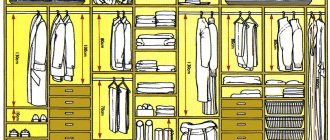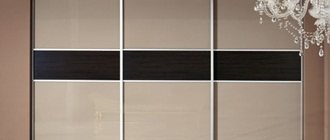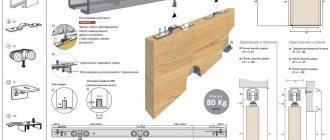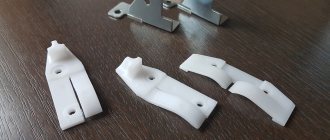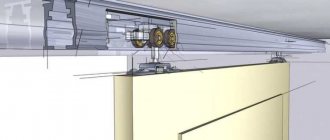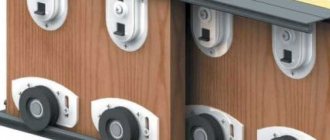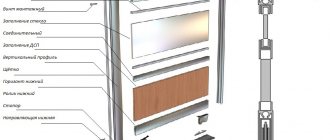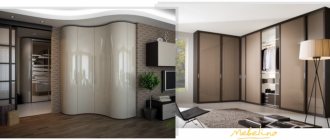When buying a new home, moving, remodeling, or simply when you want to update the design of your apartment, we always think about what furniture to choose so that it is comfortable, beautiful and functional. Of course, when considering options, we also rely on the dimensions of the future sofa, table or shelf. Everyone wants the furniture in their apartment to take up as little space as possible, especially if the area of the room does not allow you to purchase exactly what you like visually.
Closet. built into the niche of the room
A closet for clothes, linen, and personal belongings is very necessary in any room. It is suitable for storing everything that is used daily or periodically, saving items from dust settling and contamination by household liquids. For many of us, when we hear the word wardrobe, the first thing that comes to mind is the image of a familiar design with mezzanines, glass doors and drawers. You can quickly buy such furniture in a store by simply telling the seller the dimensions, choosing the color, as well as the type of product. As practice shows, suitable products are not always sold.
A dressing room hidden behind sliding doors allows you to optimally use the space and hide everything from prying eyes
A new product has appeared on the furniture market relatively recently, which has won the love of customers, devoid of many of the disadvantages of a conventional cabinet equipped with hinged doors that block the exit, entrance or space when they are opened. A sliding wardrobe can be built into a niche, which is provided during the construction of many apartments and often causes confusion about how to use it without spoiling the integral image of the living space.
Mirrored wardrobe for the corridor
Such a cabinet can be installed in the bathroom, bedroom, living room, kitchen, hallway, visually increasing the space due to, for example, mirrored doors. Its huge advantage is the unlimited dimensions (length, width, depth and height). Below we will look at the rules for correct calculation of this type of cabinets.
Sliding wardrobe for the living room with a beautiful landscape on the doors
Where to begin?
Calculation of wardrobe door sizes
Having chosen a place for installation, sketched a sketch by hand, we begin to calculate and draw the initial design of the structure. All objects located in close proximity or in contact with the structure are taken into account, distances and thickness of materials are measured, and wall unevenness is taken into account. A prerequisite for successful cabinet installation is measuring the corners. There must be one hundred percent confidence that they are straight (90%).
Sliding wardrobe with dimensions and description
A standard sliding wardrobe consists of a roof, sides, partitions, bottom, ceiling, plinth, doors, back wall and internal contents (shelves, modules with drawers, belt holders, pull-out baskets, hangers, shoe racks, etc.). The dimensions of all parts should be taken into account when preparing the product design.
Drawing of a built-in wardrobe in a niche
We compare the calculated data of compartment doors and the internal contents of the cabinet
The most important point is the ratio of internal filling and doors. Based on the fact that the door leaf does not swing open when opened, but moves on rails, it is necessary to calculate the amount of area so that it opens the space necessary to easily reach the drawers.
The optimal distance between shelves is 300 mm. But it is better to approach this issue individually.
To ensure that access to the pipe and drawers remains free, you should calculate the width of the door. The first thing to consider is the width of the vertical profile. Usually it is twenty-six millimeters. Then the width of the profile located inside is subtracted (subtract thirty-six millimeters from the total width - the thickness of the side walls). From the total, subtract the thickness of the front and back tape.
The required cabinet depth for hangers on which hanging items are located is 550–600 mm.
The formula for calculating the width of the door consists of two steps:
- The width of the internal opening + the width of both profiles that intersect.
- Divide the result by three.
Note! The main mistake in the calculations is that the door leaf, when it is open, should not block access to the drawers.
Decide what you will store in the drawers, what height they should be and how many drawers are needed.
Calculating the dimensions of the cabinet
For the initial calculation, we need to determine L - the height of the opening and B - the width of the opening
The first stage of cabinet design is marking
- Height. The basic rule to follow is not to rely only on the parameters of the walls. Why? Contact with the ceiling will not allow the wardrobe to move into the desired position. This is a rather massive structure, which is usually assembled horizontally and installed vertically. Therefore, the most important value for calculating the correct size is its diagonal, the length of which is usually approximately 10 cm less than the height of the back wall. Here it is better to use the formula √(a²-b²) = x. For example: 2700 (distance from floor to ceiling 2700 mm) x 27 = 72900 (a2); 50 (cabinet depth 50 mm) x 50 = 2500 (b2); 72900 – 2500 = 70,400. Taking the root (use an online calculator) of 70,400, we get 265.32. We round up to 265. In total, the height of our product is 2650 mm.
- Depth. Here it is worth mentioning right away that it is better to make this parameter no smaller than 550 mm, and preferably 650 mm or more, since the standard length of the hanger rod is 450 mm, so your clothes, especially bulky down jackets and fur coats, should feel comfortable in such cramped spaces. conditions. It is worth clarifying that the depth is chosen completely different, based on your preferences and the dimensions of the room.
- Width. Everything is much simpler here. We measure the internal dimensions of the opening, subtract 16 mm (chipboard thickness) from this size, and obtain the mounted values of the opening.
Basic parameters of the wardrobe
Expanded drawing for a wardrobe with a width of 2860 mm and three doors
Calculating the size of the doors
Calculation of the dimensions of sliding wardrobe doors for a built-in model
Calculating the size of cabinet doors
In this case, the main thing is to avoid mistakes made when installing a sliding wardrobe yourself.
- The parameters of one leaf should not exceed 2800 x 1200 mm.
- You should not make very narrow doors.
- It is important to take into account the overlaps of the canvases.
Design of sliding doors for wardrobes
Width calculation. When determining the length of the canvas, you should subtract 40-45 mm from the height of the opening (the required distance for hanging). To the width of the opening we add the length of the overlap in millimeters and divide by the number of doors. For example, 1584 mm + 26 mm / 2 = 805 mm (width of one leaf).
Layout of wardrobe doors (top view)
Define Guides
In order for the doors to overlap and not interfere with each other, it is necessary that the rear guide be removed from the front by the calculated result: handle thickness - outer width of the recess + 2 mm .
Example:
- Thickness 34;
- Width 16.
Result: 34 – 16 +2 = 20
The maximum space between the guides of two compartment doors should be 20 mm. This will allow the sliding flaps to fit snugly, closing the wardrobe, but the coating will not be rubbed off the handles when moving. The upper guides have wider grooves, which means they do not require additional calculations. The main thing is that the width of the recess is slightly larger than the handle.
From the article it becomes clear that furniture such as a wardrobe is quite easy to acquire. But first you need to make accurate measurements and calculations so that you don’t have to change anything during installation. If you approach the matter responsibly, following all the rules, then the cabinet will be convenient to use.
Related article: Soundproofed entrance doors: types of materials used and selection criteria
Calculation of compartment door sizes (2 videos)
Sliding wardrobes (17 photos)
Calculating the size of the boxes
Detailing drawers for a wardrobe
Drawers are a very important and practical filling of the closet. To determine the boundaries of the box, it is necessary to take into account the data of all its parts: the front, bottom, side, back wall and guide.
- Facade. The size of the opening should be 4 mm greater than the width of the facade. The height is chosen arbitrarily. Be sure to leave a groove in the facade for attaching the handle.
- Bottom. When determining the dimensions of the cabinet bottom, you need to decide whether it will be nailed or inserted into grooves. Using the latter method, it is important to take into account the thickness of the material and the depth of the groove.
- Sidewalls. Their length is a multiple or slightly longer than the length of the guide. The height of the side walls and the back wall of the box is equal to or 40-50 mm less than the height of the facade.
The size of the box affects all parameters of the retractable element: its width, depth and height
Compartment wing width
After you have decided on the height of the wardrobe doors, you need to calculate the width of the doors using the formulas:
- Opening length/number of sliding wardrobe doors = door size
- Sash size + handle size/2
Example:
- Opening length 1200;
- 2 doors;
- Handle 14.
Related article: Insulation of a wooden door in a private house: materials used and work procedure
Result: 1200 / 2=600 600 + 14/2 = 607
That is, the compartment door must be at least 60.7 cm in length. But it is best to take the maximum value of 62 cm to facilitate installation work. By adding the size of the handle, the doors will overlap when closed.
Methodology for calculating materials and components
A table must be drawn up indicating a list of all the parts of the outer box and internal filling (fittings, fasteners, handles) indicating their sizes and quantities. There are several dozen or even hundreds of such parts, depending on the configuration of the cabinet. The thickness of the edge must be taken into account, and the name of the material for each part must be indicated. You can use this data later when calculating the cost of the cabinet.
An example of filling a three-door wardrobe with an ironing board and a vacuum cleaner
To cut chipboard, a list of parts with dimensions is enough, with which you contact the cutting shop, select the material there and order the production of blanks for your cabinet.
Diagram of a 3750 mm wide cabinet with detailed measurements
When calculating materials and components, one should not neglect gaps and indentations.
- The height of the base can be up to 100 mm.
- The gap on each side of the drawer front is from 1.5 mm.
- The internal filling of the product should be approximately 10 cm less than the outer casing.
Approximate specification of a sliding wardrobe
Cabinet cost calculation
Approximate calculation of the cost of a sliding wardrobe depending on the configuration
Having in hand a table with a list and quantity of all necessary parts and materials, in the last column we write the cost of each item, focusing on the price in the store. Here it is necessary to pay special attention to the cutting of parts in the chipboard sheet (its structure, cut width, overall dimensions, which should be taken 20 mm less than the required parameters).
An example of calculating the price of a sliding wardrobe in the CupeCalc v1.0 program, built on the basis of Microsoft Excel using VBA macros
Parts made from sheet metal and various inserts, such as mirrors, are calculated by square meters. For clarity, let’s take the bottom of the structure, made of chipboard. As a basis, we take the cost of a sheet per square meter, the required width and length of the bottom (chipboard: 1100 rubles / m²; bottom: 1.5 m x 2 m = 3 m² x 1100 rubles = 3300 rubles) Long materials, such as plinths, are considered per linear meter, and do not cause any particular difficulties in assessment. Handles, latches, fasteners are counted individually.
Wardrobe designer program
So, having analyzed the information you have just read, you can begin to independently calculate the wardrobe.
Unusual wardrobe for the bedroom with two doors, lighting and additional side shelves
